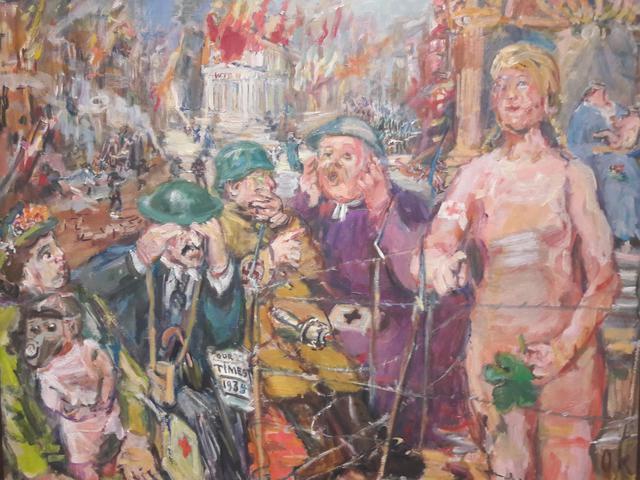Anschluss - Alice in Wonderland

"Anschluss - Alice in Wonderland" is a thought-provoking and powerful painting by the renowned artist Kokoschka, depicting a haunting scene set against the backdrop of a burning Vienna. The central focus of the painting is Alice, a symbol of truth, standing naked in the foreground, surrounded by barbed wire. This imagery conveys a sense of vulnerability and exposure, highlighting the harsh realities of war and conflict. The three male figures in the center of the canvas, each wearing a different steel helmet representing England, Germany, and France, gesture in a manner reminiscent of the three wise monkeys, embodying the concept of turning a blind eye to evil. Kokoschka's inclusion of these figures serves as a commentary on the complicity of these nations in the fate of Vienna during this tumultuous time.
The juxtaposition of innocence and destruction is further emphasized by the woman holding a baby wearing a gas mask in the left foreground. Her expression of dismay as she gazes at Alice underscores the impact of war on the most vulnerable members of society. The painting invites viewers to reflect on the consequences of political decisions and the human cost of conflict. Kokoschka's use of symbolism and imagery creates a poignant and evocative narrative that resonates with viewers long after they have left the museum.
As visitors explore the museum and come across "Anschluss - Alice in Wonderland," they are confronted with a stark reminder of the complexities of history and the enduring effects of war. The painting serves as a poignant tribute to the resilience of the human spirit in the face of adversity, urging viewers to confront uncomfortable truths and reflect on the power of art to provoke thought and inspire change. With its rich symbolism and emotional depth, "Anschluss - Alice in Wonderland" stands as a testament to Kokoschka's artistic vision and his commitment to shedding light on the darker aspects of human nature.
© ChatGPT 3.5